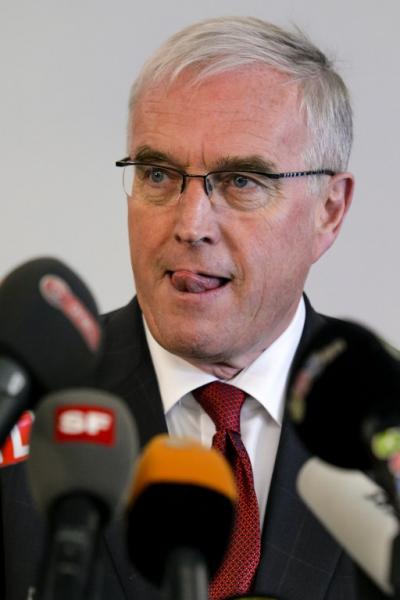McQuaid would accept rider donations in the future
Questions linger over UCI's relationship with Armstrong



UCI president Pat McQuaid’s press conference to accept USADA’s decision to strip Lance Armstrong of his seven Tour de France titles may have begun with a strongly-worded indictment of the Texan’s legacy, but it ended with questions still lingering over the UCI’s relationship with the rider during his career.
McQuaid acknowledges accepting Armstrong donation a mistake
McQuaid reveals Armstrong made two donations to the UCI
Bruyneel vows to continue fight against USADA charges
UCI to announce decision on USADA's Armstrong findings on Monday
UCI confirms Lance Armstrong's life ban
“Lance Armstrong has no place in cycling,” McQuaid said confidently, later adding that “he deserves to be forgotten in cycling now.”
But while Armstrong is forever expunged from the record books, his legacy is one that will not be readily forgotten. It continues to cast a long shadow over the sport in general and over UCI headquarters in Aigle in particular, given the governing body’s contentious decision to accept donations totalling $125,000 from Armstrong in 2002 and 2005.
In Geneva on Monday, McQuaid repeated his defence of the UCI’s acceptance of Armstrong’s twin offerings to its anti-doping fund – a 2002 donation of $25,000 that was used to fund testing in the junior ranks, and a 2005 pledge of $100,000 (eventually paid in January 2007) which went towards the purchase of a Sysmex blood analyser.
McQuaid, who was elected UCI president in 2005, again denied the allegations of Floyd Landis and Tyler Hamilton that Armstrong had donated the money in order to cover up a positive test for EPO at the 2001 Tour de Suisse. He described the accusations as being “absolutely untrue” and said that accepting the money was not a reason for him or then UCI president Hein Verbruggen to tender their resignations.
“It’s certainly not a resignation issue,” McQuaid said. “It would be best if we hadn’t done it, and if we were to do it in the future, it would be done in a different way. There is no connection between the donations that were given to the UCI and a test covered up because there was no test covered up. There was nothing to cover up.”
“At the time, in 2002 and 2005, Armstrong was a big star and there was none of this around him.”
The latest race content, interviews, features, reviews and expert buying guides, direct to your inbox!
However, the head of the Lausanne laboratory that tested Armstrong’s sample for the 2001 Tour de Suisse confirmed on Sunday that the American had returned a “suspect sample,” although it did not constitute a positive test.
Martial Saugy also told AFP that Armstrong had returned a similarly suspect sample at the following year’s Dauphiné Liberé, although McQuaid told reporters after Monday’s press conference that the UCI had never been aware of that second suspect sample.
“In 2001, we told him that we were aware that there was the suspicious test and if you look at the Tour de France which started the week after, there was aggressive testing done on him,” McQuaid said.
During the main press gathering earlier on, McQuaid had shown annoyance his annoyance when questioned on possible links between Armstrong’s 2001 sample and his donations to the UCI. “Don’t try to make the connection between the suspicious test and the donation. There were no positive tests from him,” McQuaid said.
More hesitant
After his assured opening to the press conference, McQuaid was more hesitant when pressed on why the UCI had accepted Armstrong’s donation. “We accepted it because… we used the money to assist in the fight against doping,” he said. “It was done and it was done openly and the money was put to good use.”
McQuaid also reiterated what he told Cyclingnews in November 2011 and said that the UCI would accept a similar offering from the stars of the current peloton, but would be more careful to ensure that the payment was made in a more transparent manner.
“The UCI would accept that money but accept it differently,” he said. “I’ve seen a quote from [former WADA head] Dick Pound who says he sees no problem with athletes donating to the development of the sport.”
On the issue of summoning riders such as Armstrong to Aigle to explain suspect findings in the early part of the last decade, McQuaid insisted that the limitations of testing at the time made it a necessity, while the limited scope of the UCI’s powers meant that doing anything more than issuing a warning was an impossibility.
“Whenever we were informed of suspicious tests, particularly from important riders, we called them in to the UCI and asked them what they were doing,” McQuaid said. “One of those was Tyler Hamilton and Tyler Hamilton is making a lot of news at the moment about how he is ready to fly to Switzerland and talk to the UCI. Tyler Hamilton was at the UCI and he was tackled about his activities and his response was, ‘your machines must be calibrated wrong, I’m doing nothing.’”
“We did a lot of calling people in, but it’s one person’s word against another’s and because we don’t have police powers, we couldn’t take that any further. And that happened a lot at the time.”

Barry Ryan was Head of Features at Cyclingnews. He has covered professional cycling since 2010, reporting from the Tour de France, Giro d’Italia and events from Argentina to Japan. His writing has appeared in The Independent, Procycling and Cycling Plus. He is the author of The Ascent: Sean Kelly, Stephen Roche and the Rise of Irish Cycling’s Golden Generation, published by Gill Books.